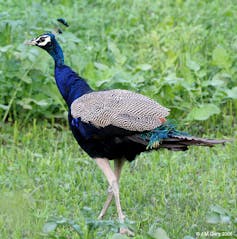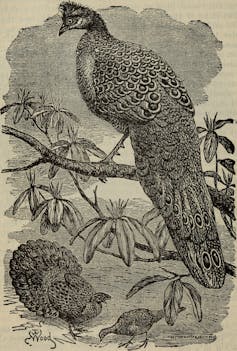In 1871, Charles Darwin introduced his theory of sexual selection by female choice in The Descent of Man. He suggested females of a species would exhibit a preference for beauty and ornamentation when choosing mates, leading to a prevalence of those traits.
Darwin claimed this explained the evolution of the peacock’s long tail. More than 150 years later, evidence from peafowl research challenges Darwin’s theory.
Our research on the peacock’s long tail discovered a simple developmental rule that explains its symmetry, complexity and beauty. It suggests peahens choose their mates on the basis of size, vigour and beauty, not beauty alone, as Darwin had thought.
Darwin’s assumptions
Darwin saw the peacock’s impractically long tail as maladaptive; it was too long to be explained by his grand theory of natural selection that held that species evolved only traits that could help them survive.
As he wrote to a fellow scientist: “The sight of a feather in a peacock’s tail, whenever I gaze at it, makes me sick!”
Darwin made two implicit assumptions that, our research shows, undermine his sexual selection theory. First, Darwin could not see that maladaptation can also be a product of adaptation since trade-offs between traits are common in nature.
Peacock tails here refer to the long, irridescent feathers that trail behind. Taller trains (the height when the feathers are fanned out) can be beneficial to males in securing mates, but at the same time, long tails are maladaptive because, for example, they may hinder escape from predators.

Second, Darwin assumed peahens admired the peacock tail “as much as we do” and the birds assessed mates on the basis of esthetic appeal. He argued that birds have a feel for beauty. Later, this explanation would set the stage for research exploring how females assess beauty in their mates.
Researchers focused on the tail’s brightly coloured eye-shaped spots, but a large number of studies have been done over the last 30 years and no uncontroversial support for eyespot-based female choice has been found.
Complexity and vision
As a fruit fly geneticist interested in the variation and evolution of sex and reproduction-related genes, I unexpectedly stumbled on the evolution of the peacock’s long tail. I noticed its excessive complexity and wondered if peahens saw what we see.
I examined museum specimens of peacock tails and made two important discoveries. First, I found that a zigzag/alternate arrangement of follicles gave rise to the symmetry, complexity and beauty of the peacock’s train. It is remarkable that this alternate arrangement, the densest form of spherical packing known, would produce such wonderful effects when applied to living things.

Second, because feathers and eyespots are parts of the same structure, the size of the train and the number of eyespots are developmentally correlated. Peahens cannot see eyespots and train size as separate traits, as we do; peahens react only to the green-blue colour of the eyespots and the eyespots are too small to see from distance. Therefore peahens view the tails as one complex trait that combines train size and some aspects of the eyespot colours.
What this means is that females cannot see eyespots without seeing the train first, which raises the possibility of direct selection based on the train and not the indirect result of selection through the attractiveness of the eyespots.
Since sexual selection and mate choice are an important part of the standard evolutionary processes involved in natural selection, there is no need for a separate sexual selection theory. Darwin was wrong in this respect.
Addressing beliefs
For a variety of reasons, the sexual selection theory found scant support during Darwin’s time. Naturalist Alfred Russel Wallace, the co-discoverer of natural selection, was among those who argued sexual selection was subsumed under natural selection.
But Darwin had other reasons to push his sexual selection theory. He used it to solve three problems at once. First, of course, to explain the evolution of secondary and often exaggerated sexual traits, particularly in birds, including peafowl.
Second, he used his theory to explain race formation in humans, arguing for inherent race-specific standards of beauty that worked as a means of isolation between races.
Prevailing Victorian views, however, held women as weak and unable to exercise decisive preference on males. They also saw appreciation of beauty as an exclusively human trait not shared with other animals. This led Darwin to craft a theory attributing beauty-based female choice in birds and beauty-based male choice in humans.
Last, Darwin used peacock feathers to challenge the religious establishment and open the door to the esthetic appreciation of the animal world — beauty, intelligence and morality, which were taken as God-given.
This research provides reasons to reflect on why sexual selection theory is controversial, even after a century and a half. Sexual selection as a process of mate choice is common sense, but sexual selection as a theory is wrong.
Rama Shankar Singh received funding from Natural Sciences and Engineering Research Council of Canada He is affiliated with Centre for Peace Studies, McMaster University.
This article was originally published on The Conversation. Read the original article.







